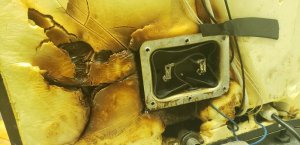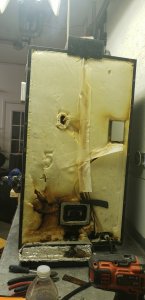I've owned my Gen1 for about 3 years. On Sunday it suddenly wouldn't heat past 80 or so degrees. There were no concerning smells being put off by the unit. So that's good anyways.
Ok, so I took it apart in search of a reason why. Upon inspection of the PCB, thermostat, snap-disc, wire, and connections the only problem I could see was a bit of scorching (not really burning) on the two connections to the heating element.
There was also evidence of long term overheating in the general area of the element service panel. So I stripped the protections off of the push connectors which were both junk anyways due to the over heating. I also pulled the thermostat and heating element and wirebrushed all of these parts and connections.
Before this "repair" was made, the unit typically would heat up to 250-255 ish when the controller read 275. Now with clean connections, it heats up to 320 (trusted thermometer placed less than 1" from the unit thermostat) with the controller reading 275.
The device seems to be cycling normally. The readings on the element posts topped out at 195 and 165 from left to right

My questions are fourfold:
1. You can see evidence of the overheating that took place overtime on the insulation. Seems to me that drilling a few holes in the element service panel would relieve most, if not all of this from happening in the future.
2. Does anyone know what temps the insulation is rated for? I never (or so I thought anyways) had an issue before, but now with the uniter heating to north of 300 degrees, I wonder if I'll be exceeding the specs of the foam.
3. What should I use to replace the now missing insulation from the push connections? I don't think that exposing the rubber housing in the element service panel to 200 plus degree temps would be advisable. I have red RTV, but that seems like it would be a big hassle to get off for when I have to service in the future.
4. Should I trust this thing to run unsupervised overnight (at some point)? I did an extensive inspection and saw no other issues. The wires and all connections were honestly in great shape. No scorching of the PCB leads, no loose parts on the snap disc, etc.
Thanks for your time :-)
Attached also is a larger picture in case there is some greater concern with the damage to the insulation than I thought.

Ok, so I took it apart in search of a reason why. Upon inspection of the PCB, thermostat, snap-disc, wire, and connections the only problem I could see was a bit of scorching (not really burning) on the two connections to the heating element.
There was also evidence of long term overheating in the general area of the element service panel. So I stripped the protections off of the push connectors which were both junk anyways due to the over heating. I also pulled the thermostat and heating element and wirebrushed all of these parts and connections.
Before this "repair" was made, the unit typically would heat up to 250-255 ish when the controller read 275. Now with clean connections, it heats up to 320 (trusted thermometer placed less than 1" from the unit thermostat) with the controller reading 275.
The device seems to be cycling normally. The readings on the element posts topped out at 195 and 165 from left to right

My questions are fourfold:
1. You can see evidence of the overheating that took place overtime on the insulation. Seems to me that drilling a few holes in the element service panel would relieve most, if not all of this from happening in the future.
2. Does anyone know what temps the insulation is rated for? I never (or so I thought anyways) had an issue before, but now with the uniter heating to north of 300 degrees, I wonder if I'll be exceeding the specs of the foam.
3. What should I use to replace the now missing insulation from the push connections? I don't think that exposing the rubber housing in the element service panel to 200 plus degree temps would be advisable. I have red RTV, but that seems like it would be a big hassle to get off for when I have to service in the future.
4. Should I trust this thing to run unsupervised overnight (at some point)? I did an extensive inspection and saw no other issues. The wires and all connections were honestly in great shape. No scorching of the PCB leads, no loose parts on the snap disc, etc.
Thanks for your time :-)
Attached also is a larger picture in case there is some greater concern with the damage to the insulation than I thought.






